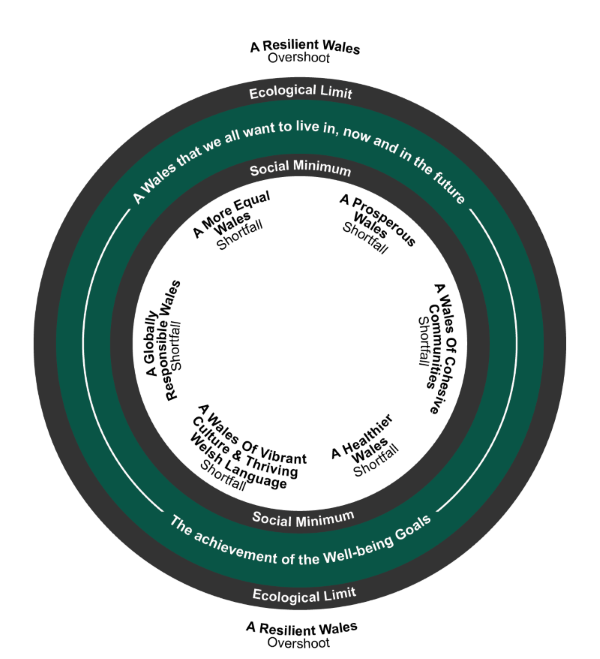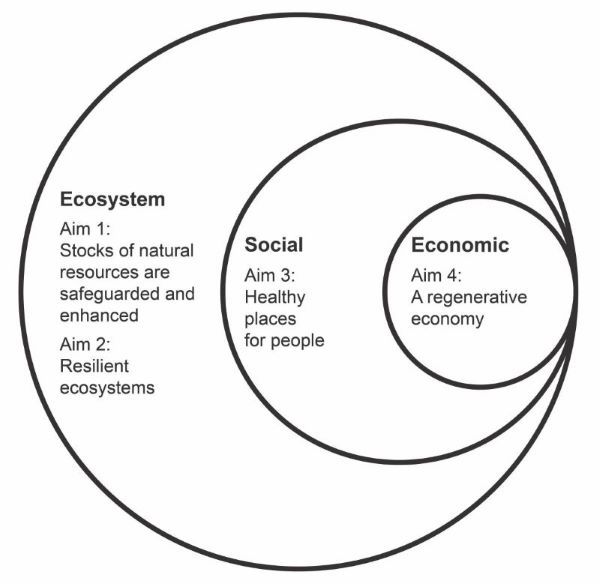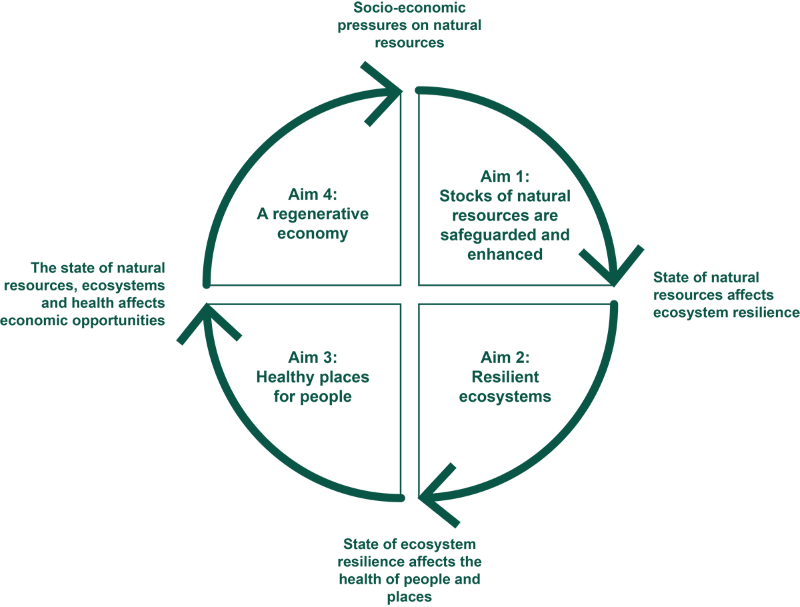SoNaRR2020: Introduction
This is the second State of Natural Resources Report (SoNaRR), required under the Welsh Environment Act 2016.
In 2016 Natural Resources Wales (NRW) published the first SoNaRR as our understanding of the implications of the Environment Act were being developed.
Since then the first natural resources policy has been published, as have the area statements; the world has recognised the nature and climate emergencies that we face; and the Covid-19 pandemic has brought a new focus on well-being. This report is written within that context.
SoNaRR2020 builds on a number of Welsh, UK and global assessments of the status and trends of natural resources. It looks at the risks those trends pose to our ecosystems and to the long-term social, cultural and economic well-being of Wales, in terms defined by the Well-Being of Future Generations (Wales) Act 2015.
Watch our video: SoNaRR2020 An introduction to the assessment
A phased publication
The Environment Act requires SoNaRR2020 to be published by the end of 2020. In these unprecedented times, we have agreed a phased publication with Welsh Government:
Our assessment of the extent to which the sustainable management of natural resources (SMNR) is being achieved, our recommendations for progress and the natural resources registers showing pressures, impacts and opportunities for action are published here, in December 2020.
In March 2021 we will publish the full assessments by ecosystem and cross-cutting theme, including biodiversity.
SoNaRR’s content and purpose is defined in the Environment Act
NRW must prepare and publish a report containing:
- An assessment of the state of natural resources in Wales
- An assessment of the extent to which the sustainable management of natural resources is being achieved
- An assessment of biodiversity to support the biodiversity duty on public bodies under section 6 of the Environment Act. Biodiversity is defined as:
‘the diversity of living organisms, whether at the genetic, species or ecosystem level’
- What NRW considers to be the main trends and factors that are affecting and are likely to affect the state of natural resources.
- Any aspects about the state of natural resources on which NRW considers it does not have sufficient information to make an assessment.
SoNaRR is an evidence base for Welsh Ministers to use when preparing or revising the Natural Resources Policy, for NRW when preparing area statements, and for local planning authorities when refreshing local development plans. SoNaRR must also be considered in the publishing, adopting or reviewing of national park and area of outstanding natural beauty management plans by relevant authorities.
Our use of broad ecosystems and cross-cutting themes
Natural resources are defined in the Environment Act as:
- Animals, plants and other organisms
- Air, water and soil
- Minerals
- Geological features and processes
- Physiographical features
- Climatic features and processes
These components combine and work together in many ways and at many scales, forming ecosystems from which humans use and obtain benefits. SoNaRR has grouped ecosystems following the system used in the UK National Ecosystem Assessment of 2011.
Using these broad ecosystems allows us to:
- Distinguish and group together the different habitats generally found there
- Describe the services we get from them and map the benefits to well-being
- Look at pressures and impacts on the resilience of those ecosystems
- Identify opportunities for action and design management interventions around the land, water and sea uses that occur there
In SoNaRR2016 we used these ecosystems as the thread throughout the report. We are still using the broad ecosystems in SoNaRR2020 but have also assessed the sustainable management of natural resources against a number of cross-cutting themes. These are the building blocks of our overall assessment and will be published as full chapters in March 2021.
Broad ecosystems:
- Coastal margins
- Enclosed farmland
- Freshwater
- Marine
- Mountain, moorland and heath
- Semi-natural grassland
- Urban
- Woodland
Cross-cutting themes:
- Biodiversity
- Climate change
- Land use and soils
- Invasive non-native species
- Air quality
- Water efficiency
- Waste
- Energy efficiency
SMNR and the well-being goals
The Environment Act defines the sustainable management of natural resources as:
'…using natural resources in a way and at a rate that maintains and enhances the resilience of ecosystems and the benefits they provide. In doing so, meeting the needs of current generations without compromising the ability of future generations to meet their needs, and contributing to the achievement of the well-being goals set out in the Well-being of Future Generations Act.'
The objective of SMNR is to build resilient ecosystems which supply ecosystem services and help Wales meet its well-being goals for a sustainable future. To do that we need to transform our socio-economic systems so that they are working more like natural regenerative systems, responding to feedback about environmental capacity and social needs.
The Welsh well-being goal of securing ‘A resilient Wales’ is about building healthy functioning ecosystems which support social, economic and ecological resilience. To secure this resilience, we need to focus on building healthy, regenerating systems.
Figure 1 takes the Doughnut economics model and combines it with the Welsh well-being goals (Raworth K, 2017). It shows how SMNR contributes to achieving the well-being goals. This would keep Wales within the safe operating space for humanity while meeting society’s needs.
The four aims of SMNR fit within the safe space for sustainable development and the achievement of the well-being goals; avoiding either a shortfall against delivering the social, economic and cultural well-being goals in the centre of the diagram or overshooting our environmental capacity around the outside.
Going beyond the outer edge of the doughnut means Wales is breaching its fair share of the planet’s environmental capacity. But reducing the environmental impact too far could mean a shortfall with an impact on social and economic well-being.

Figure 1: Figure using the Doughnut model showing 6 of Wales’s well-being goals within the social minimum and the resilient wales goal as the overshoot around the outside
The four aims of SMNR
Since the publication of SoNaRR2016 the four long-term aims of SMNR have been agreed and they guide the assessments that underpin SoNaRR2020.
Achieving SMNR means having healthy, well-functioning and resilient social, economic and eco-systems, using feedback information to stay in balance with each other as they adapt to change.

Figure 2: Diagram shows how the messages read across the four aims, with the state of natural resources in aim 1, influencing resilience in aim 2 and the flow of benefits in aims 3 and 4. The pressures from the economy in aim 4 link back back to aim 1 completing the flow of benefits and pressures.
SoNaRR2020 assesses Wales’s progress towards SMNR individually against the four aims, but it is important to note that they are inseparable and should not be seen in isolation.
Wales cannot work towards healthy places for people without resilient ecosystems and cannot make our ecosystems resilient without safeguarding stocks of natural resources. The regenerative economy safeguards and restores those stocks and is the route to the transformational change needed to achieve SMNR.

Figure 3: Figure showing the linkages and cyclical nature of the four aims of SMNR. Socioeconomic pressures on natural resources lead to effects on ecosystem resilience which lead to effects on people and places which affects economic opportunities resulting in changes to socioeconomic pressures, thus restarting the cycle.
Aim 1: Stocks of natural resources are safeguarded and enhanced
Tackling overexploitation to ensure that natural resources are safeguarded, and where possible enhanced, to meet the needs of current and future generations and to contribute to ecosystem resilience. Non-renewable natural resources (such as, aggregates, fossil fuels) are used in a sustainable manner and, where depletion is unavoidable, substitutes are put in place to meet future needs.
This applies to Wales’s use of natural resources; the impact in Wales and globally where natural resources or pollutants and waste are imported and exported.
This aim contributes to the well-being goal ‘A Resilient Wales’ and in so doing makes contributions across the other goals
Go to our assessment of SMNR aim 1
Aim 2: Ecosystems are resilient to expected and unforeseen change
Building ecosystem resilience relies upon safeguarding and enhancing natural resources and ensures the continued provision of ecosystem services which Wales relies upon for its economy and health. Resilience means ecosystems are adaptable and can resist the impacts of habitat change, climate change, pollution, invasive non-native species and other pressures.
This aim contributes in particular to the well-being goal ‘A Resilient Wales’ and in so doing makes contributions across the other goals.
Go to our assessment of SMNR aim 2
Aim 3: Wales has healthy places for people, protected from environmental risks
The environment provides regulating services which protects people from risks including air, water or noise pollution and flooding. Managing those services increases well-being resulting in the provision of a healthy environment for all. Meeting this aim is dependent on having resilient ecosystems and the health and well-being of the nation contributes to our ability to take advantage of the economic opportunities of a regenerative economy.
This aim is relevant to the well-being goals ‘A Healthier Wales’, ‘A Wales of Cohesive Communities’ and contributes to ‘A Wales of vibrant culture and thriving Welsh language’ goal.
Go to our assessment of SMNR aim 3
Aim 4: Contributing to a regenerative economy, achieving sustainable levels of production and consumption
Reducing the environmental impact of production and consumption and Wales’s global environmental footprint. The aim is for Wales to use no more than its fair share of global resources and for the economy to operate within the regenerative capacity of the Earth’s ecosystems. This aim is relevant to the well-being goals ‘A Prosperous Wales’ and ‘A Globally responsible Wales’.
Go to our assessment of SMNR aim 4.
Structure and contents
Please find below the structure and full contents of SoNaRR2020 with links to each page:
- SoNaRR2020: Our assessment
- SoNaRR2020: Ecosystems
- SoNaRR2020: Cross-cutting themes
- SoNaRR2020: Natural resource registers
- Aim 1: Stocks of natural resources are safeguarded and enhanced
- Aim 2: Ecosystems are resilient to expected and unforeseen change
- Aim 3: Wales has healthy places for people, protected from environmental risks
- Aim 4: A regenerative economy with sustainable levels of production and consumption
Read next
SoNaRR2020: Bridges to the future
Related document downloads
Download: SoNaRR2020 Executive summary report (PDF)
SoNaRR2020: Glossary (PDF)
